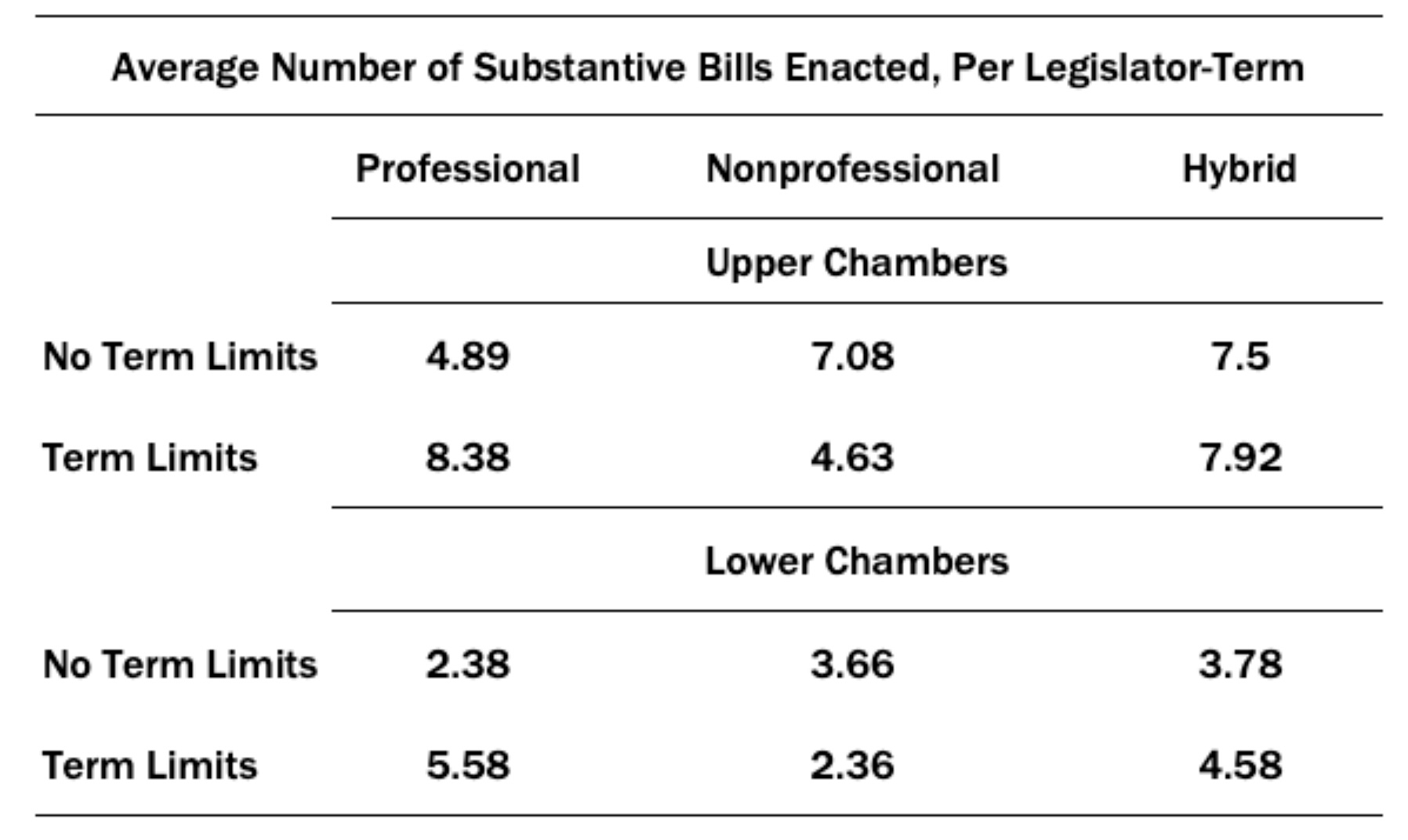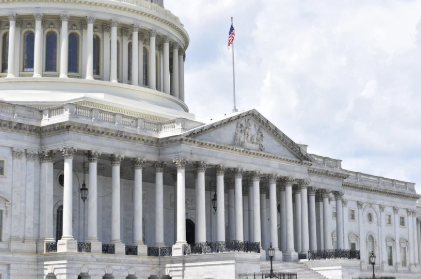What you need to know
While members of Congress are not subject to term limits, 16 state legislatures currently are, and another six previously were. In this brief, we explore how term limits sometimes affect behavior and outcomes in these legislatures.
- Twenty-two states have implemented legislative term limits, with sixteen states retaining them.
- Policy research shows that the effects of term limits on legislative productivity (e.g.: the number of actual substantive bills enacted) depend on several factors, with one being the legislature's level of professionalization.
Term Limits and Legislative Capacity
One concern with term limits is that they may reduce legislative capacity - the ability of elected officials to identify voters’ needs, draft proposals to address them, and oversee bureaucratic implementation of a bill once enacted. On the other hand, proponents of term limits often argue that term limits will increase productivity, as legislators have a shorter time to achieve their legislative goals, among other factors.
In making this specific comparison, it is important to also account for what scholars label legislative professionalism: the length of state legislative sessions, whether serving in the legislature is a full-time or part-time job, and the number of staff available to assist legislators in their work. Some states, like California, have fully professionalized legislatures similar to Congress. Others, like Vermont, have Nonprofessional legislatures that meet for short sessions with low salaries and few staff. The distinction matters because professionalized legislators are generally expected to be more productive than nonprofessionalized chambers.
The table below uses data from the National Conference of State Legislatures to divide America’s 50 state legislatures on two dimensions: whether they have term limits, and how professional they are (professional, hybrid, or nonprofessional).

One important finding from this table is that there is a mix of cases: some professionalized legislatures have term limits, while others do not.
To examine the impact of term limits on legislative productivity, we use data from the Center for Legislative Effectiveness on two dimensions: the number of substantive bills sponsored by each legislator each year and the number ultimately enacted into law.
Sponsoring a bill is a low-cost means for a legislator to signal constituents what topics the legislator supports. Sponsoring is particularly useful for someone seeking reelection who can point to sponsored bills as part of their track record. Because a term-limited legislator cannot run indefinitely, there is less incentive for them to sponsor a slew of bills.

The table above confirms one of these observations — across legislative types and chambers, legislators in term-limited states sponsor significantly fewer bills per legislator-term than those in states without term limits. Although sponsoring a large list of bills signals to a legislature's constituents what initiatives, causes and policies they care about and support, until a law is enacted, there is often little material impact from such efforts (outside of bringing awareness). Next, we consider whether term-limited states are more productive in passing substantive legislation than non-term-limited states.

The table shows that term limits increase productivity in Professional and Hybrid legislatures, but decrease productivity in Nonprofessional legislatures. Professional and Hybrid legislatures usually have more significant staff and resources to support legislators, which becomes a bigger factor in a term-limited state, where the Nonprofessional legislator may have greater difficulty navigating the political landscape without the additional years of experience and time in office. Nonprofessional legislatures also typically lack the resources to support less experienced legislators, which ultimately impacts effectiveness in both chambers when term limits are in place.
Another explanation for the difference above is that legislative staff is more important in term-limited legislatures to the extent that the staff in many cases actually ‘runs the show’ rather than the elected legislators. Without term limits, however, that same staff isn’t able to influence legislators with extensive experience, leading to fewer bills passing.
So far, we have only looked across states. To look at the impact of term limits on productivity from a different lens, we next examine those states that have enacted term limits and compare their productivity before and after implementation.

Although the data is somewhat limited, legislatures that implement term limits appear to have become less productive in terms of bills being passed after term limits were enacted than they were before, regardless of professionalization.
The Take-Away
Almost half of the states have implemented term limits in their legislatures over the past 35 years.
Implementing term limits increases productivity in Professional and Hybrid legislatures but decreases productivity in Nonprofessional legislatures.
Scholarly evidence points to term limits increasing the influence of professional staff and interest groups, but also to increasingly competitive elections.
Enjoying this content? Support our mission through financial support.
Further reading
Bucchianeri, P., Volden, C., & Wiseman, A. E. (2025). “Legislative Effectiveness in the American States,” American Political Science Review 119(1): 21–39; updated at http://www.thelawmakers.org, accessed 10/19/25.
Masket, S. E., & Lewis, J. B. (2007). A Return to Normalcy? Revisiting the Effects of Term Limits on Competitiveness and Spending in California Assembly Elections. State Politics & Policy Quarterly, 7(1), 20-38. https://tinyurl.com/bp8j3j7z, accessed 10/14/25.
Sources
Fournaies, A. & Hall, A. B. (2021). How Do Electoral Incentives Affect Legislator Behavior? Evidence from U.S. State Legislatures. American Political Science Review, 116(2), 1-15. https://tinyurl.com/4h7mj6td, accessed 10/14/25.
NCSL. (2021). Full- and Part-Time Legislatures. https://tinyurl.com/tsenjh3k, accessed 10/14/25.
NCSL. (2023). The Term-Limited States. https://tinyurl.com/ywp9z5ad, accessed 10/14/25.
Contributors
Robert Holahan (Content Lead) is Associate Professor of Political Science at Binghamton University (SUNY). He holds a PhD in Political Science from Indiana University where his advisor was Nobel Laureate Elinor Ostrom. His research focuses on natural resource policy, particularly in domestic oil and gas production, but also extends into international environmental policy. He was PI on a National Science Foundation grant that utilized a 3000-person mail-based survey, several internet-based surveys, and a series of laboratory economics experiments to better understand Americans’ perspectives on energy production issues like oil drilling and wind farm development.
William Bianco (Research Director) is Professor of Political Science at Indiana University and Founding Director of the Indiana Political Analytics Workshop. He received his PhD from the University of Rochester. His teaching focuses on first-year students and the Introduction to American Government class, emphasizing quantitative literacy. He is the co-author of American Politics Today, an introductory textbook published by W. W. Norton now in its 8th edition, and authored a second textbook, American Politics: Strategy and Choice. His research program is on American politics, including Trust: Representatives and Constituents and numerous articles. He was also the PI or Co-PI for seven National Science Foundation grants and a current grant from the Russell Sage Foundation on the sources of inequalities in federal COVID assistance programs. His op-eds have been published in the Washington Post, the Indianapolis Star, Newsday, and other venues.









